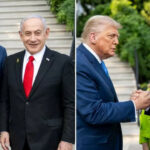Richard Nixon had his grey suits. Tony Blair had his Paul Smith suits. Barack Obama had his navy suits. Donald Trump has his very long red ties. If clothes make the man, a dark-coloured suit and a tie in party colours make the leader.
The safest look for a politician is one favoured by the leading men of our day. Take David Cameron, who, as UK prime minister, stuck to a trusty navy suit, white shirt and blue tie. A suit has long been a marker of professionalism, and following convention reassures voters that their politicians are going to follow the rules.
It’s also practical when you have to worry about running a country. Obama famously said he would restrict his choice to grey or blue suits precisely to reduce the number of decisions he had to make each day.


So accustomed are we to seeing our leaders in this uniform that when French president Emmanuel Macron was photographed on a campaign trip wearing a half-unbuttoned white shirt, or former UK prime minister Rishi Sunak wore Adidas Sambas during an interview at Downing Street, the public winced, feeling it overstepped the boundary between the appropriately detached politician and the outrageously normal person. Headlines in the UK press cried “Macron, le grand narcissist” and “Samba-gate”, and the general feeling seemed akin to the embarrassment of running into one of your teachers from school on a weekend.
But for political newcomers, the boundary between the stiffly formal and the comfortably personal has been more fluid. After he was photographed campaigning before the recent UK general election in vintage knitwear, green chinos and paisley ties, Jovan Owusu-Nepaul, 27, the aspiring Labour candidate in Clacton, was quickly labelled “the best-dressed man in politics”.
One particularly powerful image shows him conversing outside a bakery with one of his opponents, Reform UK leader Nigel Farage, who was elected as MP for Clacton. Owusu-Nepaul is in colourful knitwear and a Burberry trenchcoat, while Farage is wearing a double-breasted navy jacket and light-blue shirt. One of the two men looks more at home on a local high street.
Lynne Marks, an image consultant based in Atlanta, Georgia, whose clients include corporate executives and politicians, says an outfit is a crucial part of a wider impression. “Clothing projects messages, and a politician’s style must be consistent with his skills, talents, experience and values,” she says. “It also has to reinforce his message.”
Hazel Clark, a consultant and fashion professor at Parsons School of Design in New York, says she would advise young candidates to “be distinctive in their appearance”, noting that this “will also draw attention to their politics. Too often, older-generation politicians seem to be afraid of both these things.”

She recalls US Democratic senator John Fetterman, who — though aged 54, and whose choice of outfits has not been universally welcomed — has made dressing down a signature of his “everyman” campaign.
Studies confirm that voters form impressions of politicians based on image, finding clues about their personality. Voters look for a variety of personality attributes, but “voter-politician congruence” (a term coined by political scientists Julian Aichholzer and Johanna Willmann in 2020, meaning shared personality traits) is an important part of it.
In the social media age, it’s never been easier for candidates to show voters what sets them apart from rivals. Averie Bishop, 27, a candidate for the 112th district of the Texas House of Representatives, has posted clips on TikTok that have attracted more than 63mn likes. Besides weighing in on political issues, her videos have displayed her campaign outfits, including a fine collection of tweed blazers, trenchcoats and halter-neck maxi dresses.
In one clip, she asks followers to help pick her look for a Planned Parenthood fundraiser, sampling a selection of skirt suits and cowboy boots. “This is giving future politician, but still hip, fresh and fun,” she tells the camera.
Marks notes that these choices are deliberate and carry a promise of innovation and openness. “‘I am bright, interesting, different and my views and approach are worth listening to,’ these candidates are trying to say. ‘Try me out,’” Marks says.
Not everyone feels this break with tradition is an option. Issy Waite, 21, who ran in the UK general election as the Labour candidate for North West Essex, says dressing more formally helped her prove her maturity. “As a young person you have to prove your capability more than older people,” she explains. “I made a real point of dressing in suits and wearing heels and raised shoes to increase the likelihood of being taken seriously.”

It is in the face of considerable scepticism, then, that Justin Jones, 28, the Tennessee state representative for District 52, proves it is possible to retain a sense of individuality in one’s style even while in office. He challenged Republican bills on the floor of the Tennessee House of Representatives while wearing embroidered white and black overshirts with white button-ups, bolo ties and signet rings.
There’s another reason that young leaders are eschewing the established political dress code: cost. In an interview with GQ magazine, Owusu-Nepaul admits that when he first announced his intention to run, he was told he’d have to wear a suit, but he didn’t own one and didn’t have hundreds of pounds to spend on one. Instead, he put together campaign outfits from what he already had in his wardrobe, largely made up of charity shop finds.

A suit by former UK prime minister Tony Blair’s brand of choice, Paul Smith, can cost upwards of £1,000. Macron buys his suits at Jonas & Cie, where prices start at €430. In the US, Circle at Tufts University, a research centre that has studied the obstacles faced by young people when running for office, notes that one of the most significant barriers is the financial one.
“It is a mix of a lack of personal wealth for campaigns, perceived risk of losing current and future employment income from running for office, and perceived cost of running for office itself,” says Sara Suzuki, a senior researcher at Circle. “No doubt appearance-related costs are factored in, too.”
If young politicians are loosening their ties, then, they’re projecting personality, policy and some financial practicality. Confident, imaginative dressing may suggest confidence and imagination in a leadership role. But eschewing the traditional dress code of their country’s leaders could also work to promote the “voter-politician congruence” that helps the electorate better identify with their representatives.
By giving us glimpses of what they wear, these young candidates are transforming the idea that a politician’s image should be one distanced from our own. Political hopefuls such as Bishop in Texas are showing us what they wear in their kitchen — which, if you’re partial to an oversized jumper and gym shorts, may not be a world away from what you wear at home — while engaging 800,000-plus TikTok followers with explanations of concepts such as presidential immunity.
Sign up for Fashion Matters, your weekly newsletter with the latest stories in style — and subscribe to our podcast Life and Art wherever you listen





